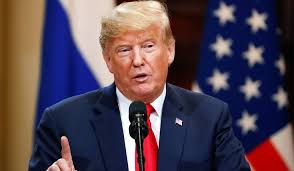The economy is being buffeted by growing concerns over the US president’s trade war
How does the current global economic outlook compare to that of a year ago? In 2017, the world economy was undergoing a synchronised expansion, with growth accelerating both in advanced economies and emerging markets. Moreover, despite stronger growth, inflation was tame – if not falling – even in economies such as the United States, where goods and labour markets were tightening.
Stronger growth with inflation still below target allowed unconventional monetary policies either to remain in full force, as in the eurozone and Japan, or to be rolled back very gradually, as in the US. The combination of strong growth, low inflation and easy money implied that market volatility was low. And with the yields on government bonds also very low, investors’ animal spirits were running high, boosting the price of many risky assets.
While US and global equities were producing high returns, political and geopolitical risks were kept largely under control. Markets gave the US president, Donald Trump, the benefit of the doubt during his first year in office; and investors celebrated his tax cuts and deregulatory policies. Many commentators even argued that the decade of the “new mediocre” and “secular stagnation” was giving way to a new “goldilocks” phase of steady, stronger growth.
Fast forward to 2018 and the picture looks very different. Though the world economy is still experiencing a lukewarm expansion, growth is no longer synchronised. Economic growth in the eurozone, the United Kingdom, Japan and a number of fragile emerging markets is slowing. And while the US and Chinese economies are still expanding, the former is being driven by unsustainable fiscal stimulus.
Worse still, the significant share of global growth driven by “Chimerica” (China and America) is being threatened by an escalating trade war. The Trump administration has imposed import tariffs on steel, aluminium and a wide range of Chinese goods (with many more to come), and it is considering additional levies on automobiles from Europe and the rest of the world. And currently the renegotiation of Nafta is stalled. Thus, the risk of a full-scale trade war is rising.
Meanwhile, with the US economy near full employment, fiscal-stimulus policies together with rising oil and commodity prices are stoking domestic inflation. As a result, the US Federal Reserve must raise interest rates faster than expected, while also unwinding its balance sheet. And, unlike in 2017, the US dollar is strengthening, which will lead to an even larger US trade deficit and more protectionist policies as Trump, assuming he remains true to form, blames other countries.
At the same time, the prospect of higher inflation has led even the European Central Bank to consider gradually ending unconventional monetary policies, implying less monetary accommodation at the global level. The combination of a stronger dollar, higher interest rates and less liquidity does not bode well for emerging markets.
Likewise, slower growth, higher inflation and less monetary-policy accommodation will temper investor sentiment as financial conditions tighten and volatility increases. Despite strong corporate earnings – which have been goosed by the US tax cuts – US and global equity markets have drifted sideways in recent months. Since February, equity markets have been buffeted by fears of rising inflation and import tariffs, and by the backlash against big tech. There are also growing concerns over emerging markets such as Turkey, Argentina, Brazil and Mexico, and over the threat posed by populist governments in Italy and other European countries.
The danger is that a negative feedback loop between economies and markets will take hold. The slowdown in some economies could lead to even tighter financial conditions in equity, bond and credit markets, which could further limit growth.
Since 2010, economic slowdowns, risk-off episodes and market corrections have heightened the risks of stag-deflation (slow growth and low inflation); but major central banks came to the rescue with unconventional monetary policies as growth and inflation were falling. Yet for the first time in a decade, the biggest risks are now stagflationary (slower growth and higher inflation). These risks include the negative supply shock that could come from a trade war; higher oil prices, owing to politically motivated supply constraints; and inflationary domestic policies in the US.
Thus, unlike the short risk-off periods in 2015 and 2016, which lasted only two months, investors have been in risk-off mode since February and markets are still moving sideways or downward. But this time the Fed and other central banks are starting or continuing to tighten monetary policies, and, with inflation rising, cannot come to the markets’ rescue this time.
Another big difference in 2018 is that Trump’s policies are creating further uncertainty. In addition to launching a trade war, Trump is also actively undermining the global economic and geostrategic order that the US created after the second world war.
Moreover, while the Trump administration’s modest growth-boosting policies are already behind us, the effects of policies that could hinder growth have yet to be fully felt. Trump’s favoured fiscal and trade policies will crowd out private investment, reduce foreign direct investment in the US and produce larger external deficits. His draconian approach to immigration will diminish the supply of labour needed to support an ageing society. His environmental policies will make it harder for the US to compete in the green economy of the future. And his bullying of the private sector will make firms hesitant to hire or invest in the US.
Over time, growth-enhancing US policies will be swamped by growth-reducing measures. Even if the US economy exceeds potential growth over the next year, the effects of fiscal stimulus will fade by the second half of 2019 and the Fed will overshoot its long-term equilibrium policy rate as it tries to control inflation; thus, achieving a soft landing will become harder. By then, and with protectionism rising, frothy global markets will probably have become even bumpier, owing to the serious risk of a growth stall – or even a downturn – in 2020. With the era of low volatility behind us, it would seem that the current risk-off era is here to stay.
The Guardian
 Lebanese Ministry of Information
Lebanese Ministry of Information



